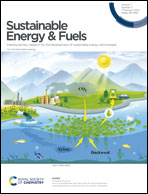Energy level modulation of TiO2 using amino trimethylene phosphonic acid for efficient perovskite solar cells with an average VOC of 1.19 V†
Abstract
The performance of planar perovskite solar cells (PSCs) is closely linked to the charge extraction and transfer in electron transporting layers (ETLs). To achieve a good control of the photoelectric properties of TiO2 ETLs, we introduce amino trimethylene phosphonic (ATMP) acid into the chemical bath deposition (CBD) process of TiO2 films. ATMP can effectively control the crystal growth of TiO2 particles to get an optimized ETL with preferable band energy and surface topography, which is beneficial for the energy level alignment and interface contact between the ETL and perovskite active layer. Compared to the control devices, the open circuit voltage (VOC) of PSCs with ATMP–TiO2 is increased from 1.17 V to 1.19 V, achieving a higher average power conversion efficiency (PCE) of 24.10%. The enhanced performance of ATMP–TiO2 PSCs is attributed to suppressed defects and well-matched energy level alignment at the perovskite/ETL interface, efficiently facilitating charge carrier extraction and electron transport. This work sheds light on designing an efficient ETL by tuning the precursor solution with environmental and inexpensive modifiers toward PSCs exhibiting outstanding performances.



 Please wait while we load your content...
Please wait while we load your content...